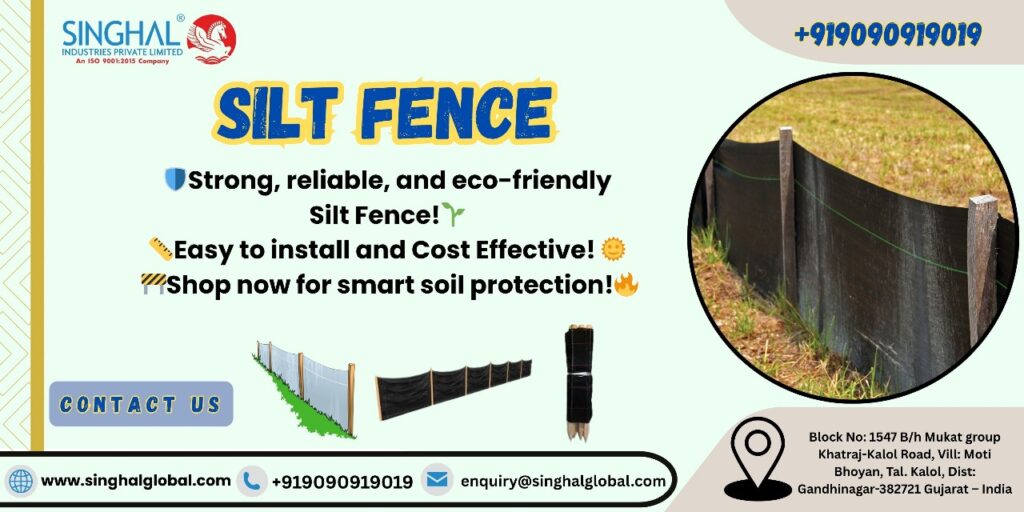The construction industry currently needs environmental responsibility. As the discussion of sustainability and the tightening of control measures to regulate erosion issues continues, construction companies are gravitating towards options that can safeguard the environment and their pockets. The silt fence is but one of those unsung superheroes of sustainability toolbox.
You all know it Design Construction sites are surrounded by a black mesh fence staked into the ground. It may sound minimal, even mundane, yet it is a considerable factor. The silt fences prevent spillage of sediments, minimize soil contamination, and preserve the surface water close to pollution. Whether you are working on a small residential site or a mega-infrastructural venture, silt fencing will help you to be green and by-the-book in terms of your present construction endeavors.
What is a Silt Fence?
A silt fence is a temporary sediment control formula constructed with porous geotextile fabric affixed to wooden or metal stakes. It is deployed on or around the edge of a construction site or disrupted soil, used to trap sediment-loaded water to reduce velocities. The fine mesh is used to entrap the sediment, but to leak out slowly. This modest idea safeguards the storm drainpipes, the rivers, and other surrounding ecosystems against being laden with soil and debris.
Above all, a silt fence is a legal requirement on most job sites as part of environmental protection legislation and local building code requirements.
Why Silt Fencing Matters in Sustainable Construction
Sustainability in construction involves not only the use of green materials or the minimization of carbon gas emissions, but also the impact of your site on the natural landscape. Whenever rain falls on bare ground, it is subject to the risk of erosion. The runoff not only erodes valuable topsoil but also washes pollutants into waterways, creating bigger ecological issues.
By putting up a silt fence, you:
- Avoid erosion of the soil and landscape deterioration
- Prevent Huge Environmental Violations
- Establish a brand of environmental friendly building
The Market for Silt Fencing in India
The need of silt fence is on the rise because the infrastructure and real state sector is booming in India. As the number of Silt fence manufacturer and supplier keeps on increasing in India, the solutions as well keep on increasing in the market to meet the need whether in the residential areas of landscaping or in government funded projects of highways.
When you purchase a silt fence at local level, the following factors will influence the Silt fence price quality of the fabric, length of rolls, the density of the mesh and the property that stake is made of. The minimum price of the individual piece is 25 per meter though it could go higher in heavy applications.
In supplier review look out:
- Geotextile fabric with inculcations of UV stabilizing to promote long duration use.
- Resistant stitching or thermal-bonding to avoid tearing
- Flat or sloped set up flexibility
- An established record in eco-engineer products
It would also be important to inquire whether your supplier will support you in site-and-specific installations, maintenance plans, and some of the best Silt fence manufacturers in India are now providing packages that support them in it.
Real-World Example: Silt Fences Saving a Wetland
Consider an example of road widening in Maharashtra. First, there was runoff in building sites which was washing away into the wetlands near it endangering the lives of animals around the area. After the complaints of the environmental groups, the project team even installed a silt fencing within the periphery of the site. Weeks later, the run off sediment loads plummeted. The wetland highlighted the importance of the fencing beside providing a solution that is helpful to save the installation project reputation.
The site supervisor said that it was just a small mesh fence as they thought. “We would have been closed down but it prevented this.”
Choosing the Right Silt Fence for the Job
Silt fences are not uniform. Based on the project you may require:
- Standard-duty fences that may be on flat or slightly-sloped locations
- Heavy rainfall Areas reinforced fences
- High-velocity runoff wire backed enclosures
- Fast deployment unit ready in a pre-packaged form with installation on multiple locations
Where it will be doubtful, consult a Silt fence manufacturers or an erosion control expert. They have the ability to prescribe the kind of design that suits your soil type, weather, and regulation of your area.
Maintenance Tips: Keep It Working
Silt fence neglect is one of the most popular ways to fail silt fence. This is how to make sure you are keeping your fence to work:
- Check after any severe rainstorm occurs
- Remove your trapped sediment, prior to it hitting half way up the fence!
- Use fabric glue to cover minor tears Patch bigger holes with cloth adhesive
- Fix broken stakes in order to keep tension up
- When the soil is stable and has been replaced by vegetation remove the fence
Some sacraments of vigilance can do much towards permanent protection of the environment.
Conclusion
When you are working with concrete, steel and deadlines, it is easy to forget to check a silt fence. Sediment control is not the cop-out that some people might think, however. It is a guarantee that your undertaking is not going to scar the landscape.
Every device available that reduces the harms is an aid that should be warmly welcomed by a responsible builder in a world that is increasingly being defined by climatic events and climatic awareness. And occasionally, that begins with some black mesh.
Frequently Asked Questions (FAQs )
Q1. What is a silt fence used for?
Silt fences; as the name suggests, are used to contain sediments during the runoff and to even prevent erosion of soil due to construction or landscaping activities. They entrap loose soil but drain filtered water thus sheltering surrounding water bodies and plants.
Q2. What color is the usual silt fences?
Majority of silt fences have black color since the color absorbs heat and fits the environment due to its color coating to the soil but some of the fences are available with bright color headers (yellow or orange) which help increase their visibility and safety.
Q3. Can silt fences be applied on slopes?
Of course silt fences can be very effective on slopes with proper installation. If the slope is steep, many trenches that follow the contour of the slope should be excavated and the fence should be well staked and reinforced with strong mesh where necessary.
Q4. Are silt fences to be maintained?
Absolutely. Wash away any accumulated sediment, inspect the material to ensure that no holes have developed, lost or broken parts should be replaced on the spot.









